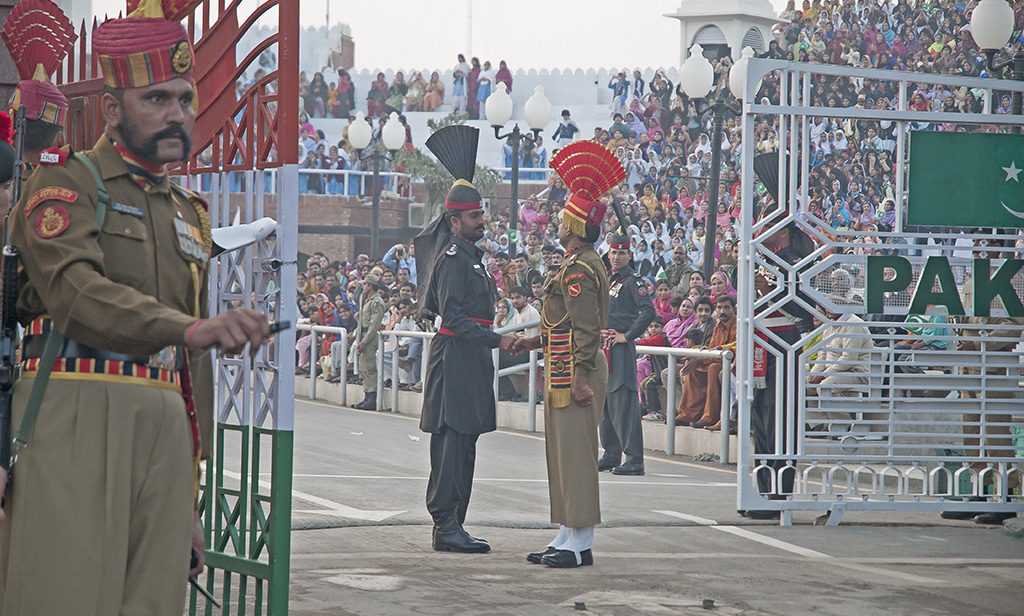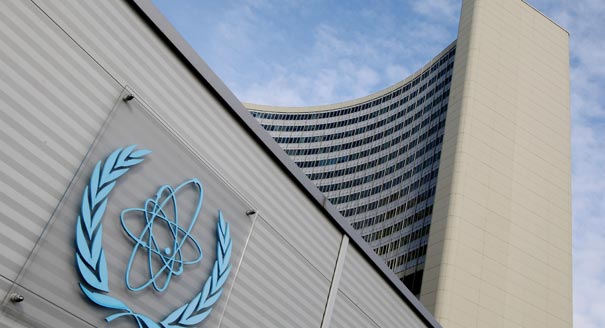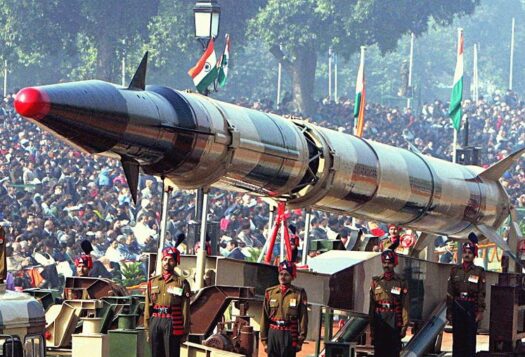
Introduction
Efforts under the international initiative on the humanitarian impact of nuclear weapons (HINW) led to adoption of Resolution L.41 by the First Committee of the United Nations General Assembly (UNGA) on October 27, 2016, and Resolution 71/258 by the UNGA on December 23, 2016. This resolution calls for a United Nations (UN) conference to negotiate a “legally binding instrument to prohibit nuclear weapons, leading towards their total elimination.” The conference held negotiations in March and June-July 2017 at the UN headquarters in New York. These led to the adoption of the Treaty on the Prohibition of Nuclear Weapons on July 7, 2017. While India and Pakistan attended all three international conferences on the HINW that preceded these negotiations, neither endorsed the U.N. resolution nor expressed any inclination toward signing on to the treaty.
India abstained from voting on the resolution by noting that the Conference on Disarmament, an established U.N. body, should have the mandate to negotiate a comprehensive instrument on nuclear disarmament. New Delhi also observed that the proposed negotiations for a treaty banning nuclear weapons would not meet the long-standing expectation of the international community for a comprehensive instrument of nuclear disarmament, especially in the absence of endorsement by nuclear-weapon states. Adding that verification would be a key component of a comprehensive instrument of global nuclear disarmament, New Delhi argued that a treaty banning nuclear weapons would not address such challenges to nuclear disarmament.
While echoing India’s argument on the need for negotiations within the Conference on Disarmament, Pakistan argued that at each step of the disarmament process, the security of every state should be kept in mind and that each of these steps should not diminish security even at the lowest possible levels of armaments and military forces. Despite their abstention, India and Pakistan provided significant support to this international initiative, being the only two states possessing nuclear weapons to have participated in the three international conferences on HINW, even though their reasons for having attended these conferences had arguably less to do with concerns over the HINW.1
India and Pakistan could further demonstrate their responsible stewardship of nuclear weapons by launching a bilateral initiative on the HINW wherein their national leaders would commit to undertake a joint assessment of the environmental and humanitarian consequences of detonations of nuclear weapons on the subcontinent. This initiative would reflect their understanding of the horrific consequences of nuclear exchanges and convey their resolve to avoid the same – not just to their own publics, but to the international community as well. This essay explores such a bilateral initiative, which, if seriously undertaken, could constitute a meaningful step that could reduce nuclear dangers in South Asia as well as strengthen regional stability.
The Proposal
Under the proposed bilateral initiative on the HINW, New Delhi and Islamabad would agree to undertake a joint scientific assessment of the environmental and humanitarian impacts of nuclear exchanges between the two South Asian nuclear powers. The two leaderships would establish a joint committee of scientific experts, environmental analysts, and humanitarian, medical, and disaster relief personnel that would conduct an independent, technical assessment of the impact of various levels of Indian and Pakistani nuclear detonations. Estimation of the number of detonations and their yields would be notional, and not based on details of actual operational devices that the two sides possess. The review would postulate varied locations for detonations. The assessment would also take into account the availability and numbers of appropriate delivery vehicles that the two countries could use to deliver nuclear warheads, based on unclassified estimates.
Once a detailed review of the environmental and humanitarian impact of nuclear exchanges between India and Pakistan is prepared within an agreed time frame, the two leaderships would jointly release the findings of the review to their publics and to the international community for study and scrutiny. Under the initiative, the two leaderships would also commit to biennial reviews of the assessment that would take into account the impact of any new, significant, and pertinent development in India and Pakistan. The leaders of India and Pakistan would also challenge other nuclear-armed rivals to carry out similar joint scientific assessments of the environmental and humanitarian impacts of nuclear detonations.
Given that a use of nuclear weapons or a nuclear war could have devastating impacts on neighboring countries as well, India and Pakistan could consider inviting experts from countries such as Afghanistan, Bangladesh, China, Nepal, and Sri Lanka, among others, at these biennial review meetings.
Challenges
There could well be opposition from within India and Pakistan to the proposed bilateral initiative on HINW. This section anticipates such challenges and contemplates ways through which they might be overcome. Within Pakistan, Rawalpindi might well oppose any initiative that diminishes the perceived value of the country’s reliance on nuclear weapons, as well as the threat of nuclear weapons’ first use to deter India’s conventional offensives. Rawalpindi’s concerns could be heightened as military planners in New Delhi contemplate the feasibility of employing the doctrine of Cold Start, wherein the Indian army would conduct low-scale, swift conventional attacks across the Line of Control or international boundaries.2 Rawalpindi would like to emphasize the threat of using its tactical nuclear weapons first, with the attendant prospect of uncontrolled escalation to prevent Indian advances.3
Rawalpindi might, however, back this initiative in light of indicators that New Delhi is contemplating massive retaliation and even preemptive use of nuclear weapons – as well as Cold Start. Two decades since overt nuclearization, the debate in New Delhi is heating up to strengthen deterrence by means of counterforce targeting.4 A joint scientific assessment of the environmental and humanitarian consequences of nuclear weapons use could reinforce voices in India that continue to regard nuclear weapons as political tools and not as instruments of nuclear warfighting. A joint assessment could remind policymakers in New Delhi of India’s long-standing commitment to nuclear disarmament, thus calling for a minimal role of nuclear weapons in India’s national security. Rawalpindi might also agree to this proposal in order to reduce international criticism of its expansive nuclear-weapons-related programs, showcasing its awareness of the disastrous consequences of the same.
The Indian government, on the other hand, might object to any initiative that could be perceived as tagging India’s standing in the global nuclear order to that of Pakistan. New Delhi has continued to cite its exceptional nuclear nonproliferation record and its commitment to nuclear disarmament while working on its integration into the global nuclear order. Since overt nuclearization in 1998, New Delhi has expressed its support for the principles of the Nuclear Non-Proliferation Treaty, despite being unable to sign it as a non-nuclear-weapon state owing to its national security concerns. With indeed an exemplary track record on nuclear nonproliferation, India is finding a more comfortable place within the global nuclear order. The 2008 waiver from the Nuclear Suppliers Group (NSG) allowing India to engage in global nuclear commerce for peaceful purposes without having to implement full-scope safeguards of the International Atomic Energy Agency reflects this transition. Pakistan has received no such waiver. New Delhi seeks increased separation from Pakistan, so why should India take part in such an initiative?

There are four reasons why New Delhi might agree to pursue a joint technical assessment with Pakistan. First, this initiative would demonstrate India’s willingness to encourage Pakistan into becoming a responsible state possessing nuclear weapons, as well as demonstrate its own commitment toward responsible nuclear stewardship. Second, by undertaking this initiative, New Delhi might advance its prospects for joining the NSG. While this may not directly soften China’s opposition to India’s entry to the NSG, it could certainly influence the position of fence-sitters. Third, the proposed bilateral initiative would underline India’s commitment to global nuclear disarmament.
In addition, New Delhi would set an example for other nuclear-weapon states to follow its lead in conducting similar assessments of the environmental and humanitarian consequences of nuclear weapons. India has for decades been calling for a treaty banning nuclear weapons that leads to a time-bound, global, and comprehensive nuclear disarmament. Former Indian Prime Minister Rajiv Gandhi’s call for a nuclear-weapons-free world in 1988 at the U.N. General Assembly is widely known in India and across the world. India could demonstrate the continuity of its commitment to nuclear disarmament by lending support to the process through this bilateral initiative.
Apart from the aforementioned two challenges posed by Rawalpindi and New Delhi, a third challenge could emerge with regard to agreement on the framework, parameters, and scope of the joint assessment. Pitfalls could occur in deciding jointly whether the assessment of the environmental and humanitarian consequences of nuclear exchanges would be scenario-specific, derived from India’s and Pakistan’s nuclear postures, or comprehensive, encompassing the use of varying numbers of nuclear weapons by the two sides. While terms of reference for the proposed joint assessment could require time to come to an agreement, this task should not be unsurmountable.
Conclusion
The proposed bilateral initiative on the humanitarian impact of nuclear weapons could offer numerous benefits to both India and Pakistan. First, it would allow them to exert political pressure on other nuclear-weapon states to undertake similar studies, whether unilaterally, bilaterally, or multilaterally. By conducting the proposed joint assessment of the environmental and humanitarian consequences of nuclear exchanges, India and Pakistan would demonstrate responsible nuclear stewardship, and thus enhance their political standing in the global nuclear order. Second, by welcoming the participation of scientific experts nominated by their neighboring governments for the biennial reviews of the study, India and Pakistan would clarify their recognition of a joint responsibility to avoid a wider regional catastrophe and to promote regional peace and stability. Third, even as India and Pakistan remain distant from the global initiative on the HINW, the proposed bilateral initiative would lend support to international efforts toward banning nuclear weapons and toward comprehensive nuclear disarmament. Finally, this initiative would promote and encourage voices from civil society within India and Pakistan that question the intensified nuclear competition now underway. The commencement of joint technical assessments of the environmental and humanitarian consequences on nuclear exchanges could help slow down the ongoing nuclear arms buildup between the two South Asian nuclear neighbors.
Editor’s Note: This essay is part of a new Stimson Center book, Off Ramps from Confrontation in Southern Asia, and has been republished with permission. The book features pragmatic, novel approaches from rising talent and veteran analysts to reduce tensions resulting out of nuclear competition among India, Pakistan, and China. The full book is available for download here.
Click here to read this article in Urdu.
Image 1: Koshy Koshy via Flickr
Image 2: Getty Images via Carnegie Endowment
***
- For more on why India and Pakistan attended the three international conferences on the HINW, see Arka Biswas and Faiqa Mahmood, “India, Pakistan and the Nuclear Humanitarian Initiative: Let’s Be Real,” Bulletin of the Atomic Scientists, April 26, 2015, http://thebulletin.org/india-pakistan-and-nuclear-humanitarian-initiative-let%E2%80%99s-be-real8256.
- See, for instance, the Indian army chief’s recent remark on the existence of Cold Start doctrine, in Sandeep Unnithan, “‘We Will Cross Again,’” India Today, January 4, 2017, http://indiatoday.intoday.in/story/lt-general-bipin-rawat-surgical-strikes-indian-army/1/849662.html.
- That Pakistan introduced tactical nuclear weapons to pour cold water on Cold Start has been mentioned by Khalid Kidwai, former head of Pakistan’s Strategic Plans Division. For more on why Pakistan threatens to use its tactical nuclear weapons first, see David O. Smith, “The U.S. Experience with Tactical Nuclear Weapons: Lessons for South Asia,” in Deterrence Stability and Escalation Control in South Asia, ed. Michael Krepon and Julia Thompson (Washington, DC: Stimson Center, 2013), 80.
- The debate picked up after Vipin Narang presented his assessment of former Indian National Security Advisor Shivshankar Menon’s book Choices: Inside the Making of Indian Foreign Policy, in which Menon discusses India’s no-first-use policy. Quoting Menon and some other Indian strategists, Narang argued that India may not allow Pakistan to use nuclear weapons first, suggesting that New Delhi might be considering a first-strike policy in certain circumstances. For Narang’s remarks and takes from Indian and Pakistani scholars on the same, see Muhammad Faisal et al., “#Nukefest2017 Hot Takes: Potential Indian Nuclear First Use?,”South Asian Voices, March 20, 2017, https://southasianvoices.org/sav-dc-nukefest2017-potential-indian-nuclear-first-use/#sthash.mXtrEym0.dpuf.


